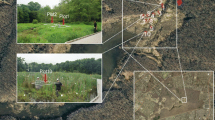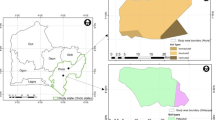Abstract
Soil organic matter content, matrix chroma, bulk density, total nitrogen, and pH were compared in naturally occurring reference wetlands and wetland creation projects in Pennsylvania. Soil samples were collected at two depths, 5 cm and 20 cm, from randomly selected points in 20 reference wetlands and 44 wetland creation projects. Reference sites contained more soil organic matter at 5 cm than wetland creation projects. Reference wetlands were higher in organic matter at 5 cm than at 20 cm, while wetland creation projects were uniform between the two depths. No relationship was found between time elapsed since construction and soil organic matter content in wetland creation projects. Neither landscape position nor wetland class significantly accounted for the variance in soil organic matter between reference wetlands and wetland creation projects. Organic matter was negatively related to pH, bulk density, and chroma and was positively related to total nitrogen. Hence, reference wetlands had lower pH, bulk density, and matrix chroma and were higher in total nitrogen than wetland creation projects. Wetland creation projects contained more sand and less clay than reference wetlands at 20 cm, and reference wetlands were siltier at 5 cm.
Similar content being viewed by others
Literature Cited
Blake, G.R. and K.H. Hartge. 1986. Bulk density. p. 365–375.In A. Klute (ed.) Methods of Soil Analysis, Part 1. Soil Science Society of America, Madison, WI, USA.
Bouma, J. 1983. Hydrology and genesis of soils with aquic moisture regimes. p. 235–281.In L.P. Wilding and N.E. Smeck (eds.) Pedogenesis and Soil Taxonomy. I. Concepts and Interactions. Elsevier, Amsterdam, The Netherlands.
Bouyoucos, G.J. 1962. Hydrometer method improved for making particle size analysis of soils. Agronomy Journal 54:464–465.
Brady, N.C. 1984. The Nature and Properties of Soils. Macmillan Publishing Company, New York, NY, USA.
Braker, W.L. 1981. Soil survey of Centre County, Pennsylvania. USDA-SCS in cooperation with the Pennsylvania State University College of Agriculture, and Pennsylvania Department of Environmental Resources State Conservation Commission. United States Government Printing Office, Washington, DC, USA.
Bremner, J.M. and C.S. Mulvaney. 1982. Nitrogen-total. p. 599–610.In A.L. Page, R.H. Miller, and D.R. Kenney (eds.) Methods of Soil Analysis, Part 2. Soil Science Society of America, Madison, WI, USA.
Brinson, M.M. 1993. A hydrogeomorphic classification for wetlands. U.S. Army Engineers Waterways Experiment Station, Vicksburg, MS, USA. Technical Report WRP-DE-4.
Brooks, R.P. 1989. Wetland protection, regulation and management. p. 21–38.In S.K. Majumdar, R.P. Brooks, F.J. Brenner, and R.W. Tiner Jr. (eds.) Wetlands Ecology and Conservation: Emphasis in Pennsylvania. The Pennsylvania Academy of Science, Easton, PA, USA.
Brooks, R.P., C.A. Cole, L. Bishel, D.H. Wardrop, D.J. Prosser, D.E. Arnold, and G.W. Peterson. 1995. Evaluating and implementing watershed approaches for protecting Pennsylvania’s wetlands. Final Report, Volume 1. Penn State Cooperative Wetlands Center Rep. No. 5, Environmental Resources Research Institute. The Pennsylvania State University, University Park, PA, USA.
Confer, S.R. and W.A. Niering. 1992. Comparison of created and natural freshwater emergent wetlands in Connecticut. Wetlands Ecology and Management 2:143–156.
Cowardin, L.M., V. Carter, F.C. Golet, and E.T. LaRoe. 1979. Classification of wetlands and deepwater habitats of the United States. U.S. Fish and Wildlife Service, Washington, DC, USA.
Craft, C.B., E.D. Seneca, and S.W. Broome. 1991. Porewater chemistry of natural and created marsh soils. Journal of Experimental Marine Biology and Ecology 152:187–200.
Dahl, T.E. 1990. Wetlands: losses in the United States 1780’s to 1980’s. United States Department of Interior, Fish and Wildlife Service, Washington, DC, USA.
Eckenrode, J.J. 1985. Soil survey of Union County, Pennsylvania. USDA-SCS in cooperation with the Pennsylvania State University College of Agriculture, and Pennsylvania Department of Environmental Resources State Conservation Commission. United States Government Printing Office Washington, DC, USA.
Farley, W.H. 1985. Soil survey of Cambria County, Pennsylvania. USDA-SCS in cooperation with the Pennsylvania State University College of Agriculture, and Pennsylvania Department of Environmental Resources State Conservation Commission. United States Government Printing Office, Washington, DC, USA.
Federal Interagency Committee for Wetland Delineation (FICWD). 1989. Federal manual for identifying and delineating jurisdictional wetlands. USACE, USEPA, USDI-FWS, and USDA-SCS. Cooperative technical publication, United States Government Printing Office, Washington, DC, USA.
Gambrell, R.P. and W.H. Patrick Jr. 1978. Chemical and microbiological properties of anaerobic soils and sediments. p. 375–411.In D.D. Hook and R.M.M. Crawford (eds.) Plant Life in Anacrobic Sediments. Ann Arbor Science Publishers, Ann Arbor, MI, USA.
Gwin, S.E. and M.E. Kentula. 1990. Evaluating design and verifying compliance of wetlands created under section 404 of the Clean Water Act in Oregon. U.S. Environmental Protection Agency, Environmental Research Laboratory, Corvallis, OR, USA.
Kentula, M.E., R.P. Brooks, S.E. Gwin, C.C. Holland, A.D. Sherman, and J.C. Sinfneos. 1992. An approach to improved decision making in wetland restoration and creation. U.S. Environmental Protection Agency, Environmental Research Laboratory, Corvallis, OR, USA.
Magee, T.K., S.E. Gwin, R.G. Gibson, C.C. Holland, J.E. Honea, P.W. Shaffer, J.C. Sifneos, and M.E. Kentula. 1993. Research plan and methods manual for the Oregon wetlands study. U.S. Environmental Protection Agency, Environmental Research Laboratory, Corvallis, OR, USA. EPA/600/R-93/072.
Maltby, E. 1987. Soils science as a base for freshwater wetland mitigation in the northeastern United States. p. 17–52.In J.S. Larson and C. Neill (eds.) Mitigating Freshwater Wetland Alterations in the Glaciated Northeastern United States: and Assessment of the Science base. Environmental Institute, University of Massachusettes, Amherst, MA, USA.
Martin, G.D. 1985. Soil survey of Wayne County, Pennsylvania. USDA-SCS in cooperation with the Pennsylvania State University College of Agriculture, and Pennsylvania Department of Environmental Resources State Conservation Commission. United States Government Printing Office, Washington, DC, USA.
McLean, E.O. 1982. Soil pH and lime requirement. p. 199–224.In A.L. Page, R.H. Miller and D.R. Kenney (eds.) Methods of Soil Analysis, part 2, Soil Science Society of America, Madison, WI, USA.
Merkel, E.J. 1978. Soil survey of Centre County, Pennsylvania. USDA-SCS in cooperation with the Pennsylvania State University College of Agriculture, and Pennsylvania Department of Environmental Resources State Conservation Commission. United States Government Printing Office. Washington, DC, USA.
Ponnamperuma, F.N. 1972. The chemistry of submerged soils. Advances in Agronomy 24:29–96.
Soil Survey Staff. 1975. Soil Taxonomy: A basic system of soil classification for making and interpreting soil surveys. United States Government Printing Office, Washington DC, USA. USDA-SCS Agricultural Handbook No. 436.
Storer, D.A. 1984. A simple high sample volume ashing procedure for determination of soil organic matter content. Communications in Soil Science and Plant Analysis 15:759–772.
Taylor, D.C. 1969. Soil survey of Centre County, Pennsylvania. USDA-SCS. United States Government Printing Office, Washington, DC, USA.
Tiner, R.W. 1989. Current status and recent trends in Pennsylvania’s wetlands. p. 368–378.In S.K. Majumdar, R.P. Brooks, F.J. Brenner, and R.W. Tiner (eds.) Wetlands Ecology and Conservation: Emphasis in Pennsylvania. The Pennsylvania Academy of Science, Easton, PA, USA.
United States Environmental Protection Agency (USEPA). 1989. Highlights of section 404: federal regulatory program to protect waters of the United States. Office of Wetlands Protection, Washington, DC, USA.
Vepraskas, M.J. 1992. Redoximorphic features for identifying aquic conditions. North Carolina State University. Raleigh, NC, USA. North Carolina Agricultural Research Service Technical Bulletin 301.
Vepraskas, M.J., S.J. Teets, J.L. Richardson, and J.P. Tandarich. 1995. Development of redoximorphic features in created wetland soils. Wetlands Research, Inc. Chicago, IL, USA. Technical Paper No. 5.
Wentworth, T.R., G.P. Johnson, and R.L. Kologiski. 1988. Designation of wetlands by weighted averages of vegetation data: a preliminary evaluation. Water Resources Bulletin 24:389–396.
Author information
Authors and Affiliations
Rights and permissions
About this article
Cite this article
Bishel-Machung, L., Brooks, R.P., Yates, S.S. et al. Soil properties of reference wetlands and wetland creation projects in Pennsylvania. Wetlands 16, 532–541 (1996). https://doi.org/10.1007/BF03161343
Received:
Revised:
Accepted:
Issue Date:
DOI: https://doi.org/10.1007/BF03161343




